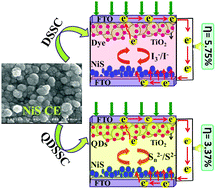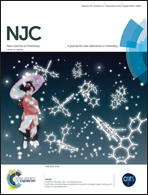Solution-processed morphology-controllable nanosphere structured highly efficient and stable nickel sulfide counter electrodes for dye- and quantum dot-sensitized solar cells
Abstract
Metal sulfide counter electrodes comprising NiS nanosphere thin films were deposited on a fluorine-doped tin oxide (FTO) substrate with different concentrations of urea. The electrodes were used as counter electrodes (CE) in solar cells. The surface morphology of the NiS thin film is greatly affected by the addition of urea, which increases the rate of thioacetamide decomposition and thus the sulfur concentration. Field emission scanning electron microscopy observes that NiS mostly exhibits a nanosphere morphology, which facilitates charge carrier transfer from their surface to redox electrolyte. In the present study, the size of the NiS nanosphere depends on the concentration of urea. Under simulated solar light irradiation with an intensity of 100 mW cm−2 (AM 1.5), the dye-sensitized solar cell (DSSC) based on the NiS CE achieves a power conversion efficiency of 5.75%, which is higher than the solar cell based on platinum (Pt) CE (5.28%). The improved photovoltaic performance of the NiS-based DSSC may be attributed to a low charge transfer resistance (33.01 Ω) for the reduction of redox couple (I−/I3−) on the CE, indicating greater electrocatalytic activity of the NiS. Electrochemical impedance spectroscopy (EIS) and Tafel polarization measurements demonstrate better catalytic activity of the NiS CE, which supports the rate of triiodide reduction to a level comparable to that of a Pt electrode. NiS CE could maintain the cell relatively high performance in the stability test in 10 h. The NiS CEs are believed to be a versatile candidate for further improvement of the power conversion efficiency of DSSCs based on the I−/I3− redox couple. The optimized NiS CE, when introduced to CdS/CdSe/ZnS quantum-dot-sensitized solar cells with a polysulfide electrolyte, exhibited a power conversion efficiency of 3.37%. The encouraging results show the potential for the utilization of the NiS CE in sensitized solar cells.


 Please wait while we load your content...
Please wait while we load your content...